Hamilton Beach 29882 HomeBaker™ 2 Lb. Breadmaker – Use Manual – Use Guide PDF. Documents: Go to download!User Manual
- User Manual – (English, French, Spanish)
Warranty
- Warranty – (English)
Specification
- Spec Sheet (web) – (English)
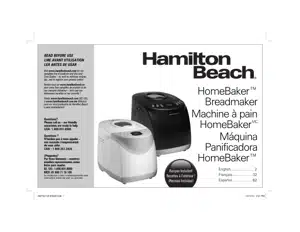
Table of contents
Parts and FeaturesQuick-Start GuideControl PanelDetailed InstructionsRemoving BreadCleaningTips: Bread BasicsTips: Use Exact MeasurementsFrequently Asked QuestionsTroubleshooting
User Guide HomeBaker Breadmaker
Parts and Features

Quick-Start Guide
BEFORE FIRST USE: Wash and dry bread pan and kneading paddle. NOTE: Do not use metal utensils in bread pan since they may damage the nonstick surface.
CAUTION! Falling Object Hazard. Breadmaker can wobble and walk during kneading cycle. Always position it in the center of the counter away from the edge.
1. Add Ingredients
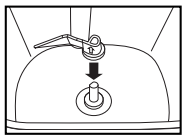
- Place kneading paddle on shaft, with arrow pointing up, pushing down as far as it will go, making sure flat surfaces are lined up

- Carefully measure and add ingredients to the bread pan in the EXACT order given in the recipe.
- TIP: Premeasure all ingredients, including add-ins (nuts, raisins), prior to beginning

- Place bread pan in the breadmaker, turning clockwise until it locks into place. Close cover.
- NOTE: Bread pan must lock into place for proper mixing and kneading
2. Select Cycle
- Press CYCLE button until desired program number appears on the digital display.
- Press CRUST and LOAF SIZE buttons to ADJUST to desired setting (not adjustable in some cycles)
- To program a Delayed Start, use the DELAY TIMER + or – buttons to add up to 12 hours before Cycle will start. Refer to page 10 for additional information.
3. Start Making Bread
- Press START/STOP. The digital display will show the time remaining in the cycle.
- Add-ins: After the second kneading cycle, 10 beeps will signal you to add fruit, nuts, etc.
- Once complete, breadmaker will beep and begin Keep Warm cycle for up to 1 hour. Press START/STOP button for 2 seconds to cancel the Keep Warm cycle and turn off breadmaker.
- Using oven mitts, turn counterclockwise to unlock the bread pan, and pull bread pan straight up. Still using oven mitts, shake loaf from pan and let cool for 10 minutes.
Control Panel

Preprogrammed Cycles
- Basic
- French
- Gluten-Free
- Quick
- Sweet
- 1.5lb. Express
- 2.0lb. Express
- Dough
- Jam
- Cake
- Whole Grain
- Bake
CYCLE Press CYCLE button to select your desired cycle. The corresponding cycle number is shown on the display.
CRUST COLOR Press CRUST button to move the arrow to desired setting: Light, Medium, or Dark crust. (Crust is not adjustable in Cycles 8, 9, 10, 11, and 12.)
LOAF SIZE Press the LOAF SIZE button to move the arrow to 1.5- or 2-lb. loaf size. (Loaf size is not an option in Cycles 4, 6, 7, 8, 9, 10, and 12.)
DELAY TIMER Use the Delay Timer feature to start the breadmaker at a later time. Press the + and – buttons to increase the cycle time shown on the display. Add up to 13 hours including the delay time and breadmaking cycle.
NOTES:
- Set the Delay Time after selecting Cycle, Loaf Size, and Crust Color.
- The 1.5 lb. Express, 2 lb. Express, and JAM cycles do not have a delay function.
- Do not use the timer function with recipes that include dairy or other ingredients, such as eggs, milk, cream, or cheese. START/STOP BUTTON Press the
START/STOP button once to start a cycle. A short beep will be heard, the colon in the time display will begin to flash, and the cycle will start. To remove bread, press the START/STOP button to end the baking cycle. To cancel a cycle, press the START/STOP button for at least 2 seconds.
POWER INTERRUPTION In the event of a power outage, the process of making bread will continue automatically within 5 minutes. If the interruption time is longer than 5 minutes, the unit will not continue running and the display will revert back to the default setting (Cycle 1, Medium Color, and 2-lb. loaf). If the dough has started rising, discard the ingredients in the bread pan and start over. If the dough has not entered the rising phase, you can press the START/STOP button to continue the cycle from the beginning.
WARNING DISPLAY
“HHH” – This warning means that the temperature inside of the bread pan is too high. Stop the program, unplug the power cord, open the cover, and let the machine cool down completely before restarting.
“LLL” – This warning means that the temperature inside of the bread pan is too low. The room temperature is too low for the breadmaker to function.
KEEP WARM After baking cycle is complete, the bread machine will shift to the Keep Warm setting for 1 hour. To cancel the Keep Warm process, press the START/STOP button for 2 seconds. TIP: Removing bread immediately after baking cycle is complete will prevent crust from becoming darker.
Detailed Instructions
1. Using the bread pan handle, turn the bread pan counterclockwise and then pull it out of the appliance.
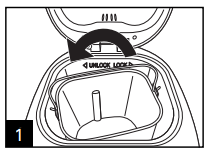
2. Push the kneading paddle onto the drive shaft inside the bread pan. w CAUTION Falling Object Hazard: Breadmaker can wobble and walk during kneading cycle. Always position it in the center of the counter away from the edge.

3. Add the ingredients to the bread pan in the order listed in the recipe. First, add the liquids, sugar, and salt; then the flour; and last the yeast. NOTE: Make sure that yeast does not come into contact with salt or liquids.
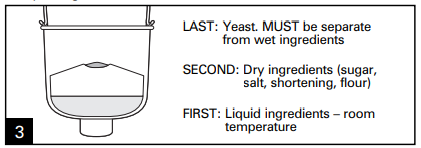
4. Place the bread pan into the appliance and make sure it is firmly locked in place by turning it clockwise. Close the lid.
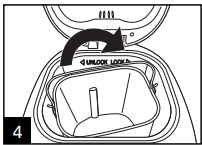
5. Plug in the appliance. A beep will be heard and the display will default to Cycle 1.
6. Press the CYCLE button until your desired cycle is displayed.
7. Press the LOAF SIZE button to move the arrow to 1.5- or 2-lb. loaf size. (Loaf size is not an option 7 in Cycles 4, 6, 7, 8, 9, 10, and 12.)
8. Press the CRUST button to move the arrow to desired setting: Light, Medium, or Dark crust. 8 (Crust is not adjustable in Cycles 8, 9, 10, 11, and 12.)
Read more : Best Substitute for Cumin
9. If desired, set the DELAY TIMER with the + and – buttons. (Delay function is not available in Cycles 6, 7, and 9.) NOTE: Do not use this feature when using dairy, eggs, etc.
10. Press the START/STOP button to begin the cycle. Breadmaker will beep once and the “:” in the digital display will begin to flash indicating the timer is counting down. The kneading paddle will begin to mix your ingredients. If Delay Timer was activated, kneading paddle will not mix ingredients until cycle is set to begin.
11. For add-ins (nuts, raisins), the machine will beep at the start of the second kneading. Open the lid and pour in your add-ins. This timing 11 varies by cycle. (Refer to the Timetable for Cycles chart.)
12. Once the cycle is complete, the machine will beep 10 times and shift to the Keep Warm setting for 1 hour
13. To stop the machine, press the START/STOP button for 2 seconds and the Keep Warm setting will end. Unplug the power cord and then 13 open the lid using oven mitts.
14. Let the bread pan cool down slightly before removing the bread. Using oven mitts, carefully turn the bread pan counterclockwise to unlock and lift up on the handle to remove from the machine.
15. Using oven mitts, turn the bread pan upside down (with the bread pan handle folded down) onto a wire cooling rack or clean cooking surface and gently shake until bread falls out. Use a nonstick spatula to gently loosen the sides of the bread from the bread pan.
16. If kneading paddle remains in the bread, gently pry it out using a spatula or small utensil. When not in use or when operation is complete, unplug the power cord.
NOTE: Store remaining bread in a sealed plastic bag for up to three days at room temperature. To store for a longer time, place sealed plastic bag in refrigerator for up to 10 days.
Removing Bread
When baking is complete, the unit will switch to the Keep Warm setting for up to 1 hour. Press and hold the START/STOP button for 2 seconds to end this cycle before removing bread pan.
Bread pan and baking chamber will be hot and oven mitts should be used. Remove the bread pan by lifting the handle and turning it counterclockwise to unlock it from the base of the chamber.
Carefully shake the bread upside down until the loaf falls out of the bread pan. Allow to cool on a wire rack for 10 minutes before slicing.
TIP: If the kneading paddle comes out in the loaf, remove it with a spatula or small utensil
Slicing
Allow to cool for 10 minutes and slice with a bread knife.

Storing Homemade Bread
Fresh-baked bread is best when consumed as soon as possible. To store, wrap cooled loaf in foil or a plastic bag to preserve freshness. Bread can be frozen for up to 6 months.
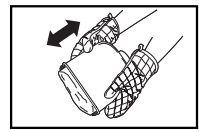
Cleaning
WARNING: Disconnect power before cleaning. Do not immerse cord, plug, or housing in any liquid. Allow breadmaker to cool down completely before cleaning.
- To clean kneading paddle: If the kneading paddle is difficult to remove from the bread, add water to the bottom of the bread pan and allow to soak for up to 1 hour. Wipe the paddle carefully with a damp cloth. The kneading paddle is dishwasher-safe.
- To clean bread pan: Remove the bread pan by turning it counterclockwise. Wipe inside and outside of bread pan with a damp cloth. Do not use any abrasive agents, in order to protect the nonstick coating. The bread pan must be dried completely before installation. NOTE: The bread pan and kneading paddles are dishwasher-safe. The outside of the bread pan and base may discolor. This is normal.
- To clean housing and top lid: After use, allow unit to cool. Use a damp cloth to wipe lid, housing, baking chamber, and interior of viewing window. Do not use any abrasive cleaners for cleaning, since this will degrade the high polish of the surface. Never immerse the housing into water for cleaning.
- Before the breadmaker is packed for storage, ensure that it has completely cooled down, is clean and dry, and the top lid is closed.
Tips: Bread Basics
Flour
All-Purpose Flour Flour that contains no baking powder, suitable for “quick” breads or bread made with the Quick settings. Bread flour is better suited for yeast breads.
Bread Flour Bread flour is the most important ingredient of making bread and is recommended in most yeast-bread recipes. It has a high gluten content and can keep the size of the bread from collapsing after rising. Flour varies by region. For example, American flour is milled from hard spring wheat; Canadian flour is milled from hard winter wheat.
Self-Rising Flour Flour that contains baking powder, used especially for making cakes. Do not use self-rising flour in combination with yeast.
Whole-Wheat Flour Whole-wheat flour is ground from the entire wheat kernel. Bread made with all or part whole-wheat flour will have higher fiber and nutritional content. Whole-wheat flour is heavier and, as a result, loaves may be smaller in size and have a heavier texture.
Other Ingredients
Egg Eggs can improve bread texture and make the bread larger in size. The egg must be whisked in with the other liquid ingredients.
Salt Salt is necessary to improve the bread flavor and crust color. It is also used to restrain yeast activity.
Shortening, Butter, and Vegetable Oil Shortening and butter should be cut into small pieces before adding to liquid.
Sugar Sugar is “food” for the yeast and also increases the sweet taste and color of bread. It is a very important element of making the bread rise. White sugar is normally used; however, brown sugar, powdered sugar, or cotton sugar may also be called for in some recipes.
Water and Other Liquids (always added first) Water is an essential ingredient for making bread. Generally speaking, water should be at room temperature. Some recipes may call for milk or other liquids. Never use dairy with the Delay Timer option.
Yeast Yeast is a living organism and should be kept in the refrigerator to remain fresh. It needs carbohydrates found in sugar and flour as nourishment. Yeast used in breadmaker recipes will be sold under several different names: Bread machine yeast (preferred), active-dry yeast, and instant yeast. Before using, check the expiration date of the yeast. Return to refrigerator immediately after each use.
Tips: Use Exact Measurements
One of the most important steps of making good bread is the proper measurement of ingredients. Measure each ingredient carefully and add to your bread pan in the order given in the recipe.
Adding Sequence
Always add ingredients in the order given in the recipe.
- FIRST: Liquid ingredients
- SECOND: Dry ingredients
- LAST: Yeast
The yeast should only be placed on the dry flour and never come in contact with the liquid or salt. When you use the Delay Timer function for a long time, never add perishable ingredients such as eggs or milk
Liquid Ingredients
Water, fresh milk, or other liquids should be measured with a glass measuring cup with clear markings and a spout. Set the cup on the counter and lower yourself to check the liquid level. When measuring cooking oil or other ingredients, clean the measuring cup thoroughly in between.
Liquid Measurement Conversion Chart

Dry Measurements
Measure dry ingredients by gently spooning flour, etc., into the measuring cup and then, once filled, leveling off with a knife. Never use the measuring cup to scoop your dry ingredients directly from a container as this could add up to one tablespoon of extra ingredients. Do not tap the bottom of the measuring cup or pack down.
HINT: Before measuring, stir the flour to aerate it.
Read more : Chicken Recipes – Chicken Kiev Jamie Oliver Style
When measuring small amounts of dry ingredients, such as salt or sugar, use a measuring spoon, making sure it is leveled off. Weighing dry ingredients with a digital scale will provide better baking results.

Dry Measurement Weight Equivalents
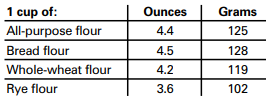
Frequently Asked Questions
May I use a sugar substitute in place of sugar?
Sugar is necessary for the yeast to produce a light loaf with a good height. Results may vary with the type and amount of sugar substitute used. If you are going to use an artificial sweetener, choose one that is aspartame-based rather than saccharin-based.
May I omit the salt or sugar from the recipe?
No, both the sugar and salt play an important role in the breadmaking process. Salt prevents the yeast from overreacting and the bread from overrising. The combination of sugar, salt, and yeast is a key part of the breadmaking process. Remember that the total sugar and salt amounts are divided among all the slices, so the amount of sugar and salt per serving is small.
When do I add raisins, nuts, etc., to the bread?
This breadmaker will beep at the start of the second kneading to let you know when to add raisins, nuts, seeds, etc. This timing varies by cycle. (Refer to the Timetable for Cycles chart.) If you are using the Delay Start timer and it is more convenient, you may add ingredients at the start.
Can I open the lid while the breadmaker is operating?
This breadmaker is designed with a window in the lid to let you watch your bread’s progress. Quick checks are OK in the early stages of kneading and to add ingredients when the beeper sounds. However, the temperature in the baking chamber adjusts for the Rising and Baking stages. Opening the lid during these steps could cause the loaf to fall or not bake properly. Sometimes condensation forms on the window after initial mixing and kneading. It usually disappears once the baking cycle starts so you should be able to get a clear view of your loaf.
Can I use my favorite bread recipes in my breadmaker?
Yes, but you will need to experiment to get the right proportion of ingredients. Become familiar with the unit and make several loaves of bread with recipes provided before you begin experimenting. Never exceed a total amount of 4 1/4 (1 L) cups of dry ingredients (that includes flours, oats, cornmeal, etc.). Use the recipes in this book to help determine the ratio of dry ingredients to liquid and amounts of yeast, sugar, salt, and butter/margarine to use.
What will happen if I leave the bread in the bread pan after baking?
This unit has a 60-minute Keep Warm cycle that lets you leave the bread in the pan for up to an hour after baking is complete. Once the warming cycle is over, it is best to remove the bread immediately or the bottom of your loaf will absorb moisture and become soggy.
Can the recipe be cut in half?
No, it is not recommended. The ingredient proportions work better in the full amounts.
How can bread mixes be used in the machine and at what setting?
The package instructions will list the amount of water and amount of yeast to use. Be sure to add liquid, then dry ingredients, followed by yeast. Do not allow the yeast to sit in the liquid. The bread type setting is dependent upon the type of bread mix being used (i.e., White bread uses the Basic bread setting; Sweet Bread setting is for use with dried fruit, cheese, or nuts; whole-wheat or multigrain should use the Whole Grain setting; Crust setting, either Light or Dark, is a personal preference). Do not use bread mixes that exceed 2-lb. (907-g) loaf size.
What is the difference between American flour and Canadian Flour?
Canadian flour has a higher protein or gluten content than American flour. You can substitute US flour in even amounts for Canadian flour. However, Canadian flour may absorb more moisture. Check your dough during the first kneading cycle. If it appears dry, you may add up to 1 Tablespoon (15 ml) of additional water per cup of flour in the recipe. Add the water 1 Tablespoon (15 ml) at a time until desired consistency of a soft and supple dough is reached.
Troubleshooting
Odor or burning smell.
- Flour or other ingredients have spilled into the baking chamber.
- Stop the breadmaker and allow to cool completely. Wipe excess flour, etc., from the baking chamber with a paper towel. TIP: Measure ingredients over the counter, adding them to the bread pan prior to insertion into the machine.
Ingredients not blending; can hear motor turning.
- Bread pan or kneading paddle may not be installed properly.
- Make sure kneading paddle is set all the way on shaft.
- Too many ingredients.
- Measure ingredients accurately.
“HHH” displays when START/STOP button is pressed.
- nternal temperature of breadmaker is too high.
- Allow unit to cool down in between cycles. Unplug unit, open lid, and remove bread pan. Allow to cool 15-30 minutes before beginning new cycle.
Window is cloudy or covered with condensation.
- May occur during mixing or rising cycles.
- Condensation usually disappears during baking cycle. Clean window well in between uses.
Kneading paddle comes out with the bread.
- Thicker crust with dark crust setting.
- It is not uncommon for the kneading paddle to come out with the bread loaf. Once the loaf cools, remove the paddle with a spatula.
- Choose a lighter crust (Cycles 1- 7only).
Dough is not blending thoroughly; flour and other ingredients are built up on sides of pan; bread loaf is coated with flour.
- Bread pan or kneading paddle may not be installed properly.
- Make sure bread pan is securely set in unit and kneading paddle is firmly on shaft.
- Too many dry ingredients.
- Make sure ingredients are measured accurately and added in the proper order.
- Gluten-free dough is typically very wet. It may need additional help by scraping sides with a rubber spatula.
- Excess flour can be removed from loaf once baked and cooled. Add water, one tablespoon at a time, until dough has formed into a ball.
Bread rises too high or pushes lid up.
- Ingredients not measured properly (too much yeast, flour).
- Measure all ingredients accurately and make sure sugar and salt have been added.
- Kneading paddle not in bread pan.
- Try decreasing yeast by 1/4 teaspoon (1.2 ml).
- Forgot to add salt.
- Check installation of kneading paddle.
Bread does not rise; loaf is short.
- Inaccurate measurement of ingredients or inactive yeast.
- Measure all ingredients accurately.
- Check expiration date of yeast and flour.
- Lifting lid during cycles
- Liquids should be room temperature.
Bread has a crater in the top of the loaf once baked.
- Dough has risen too fast.
- Measure all ingredients accurately.
- Too much yeast or water.
- Decrease yeast or water slightly.
- Incorrect cycle chosen for the recipe.
Crust color is too light.
- Opening the lid during baking.
- Do not open lid during baking.
- Select a darker crust option (Cycles 1-7 only).
Crust color is too dark.
- Too much sugar in the recipe
- Decrease sugar amount slightly.
- Select a lighter crust option (Cycles 1-7 only).
Bread loaf is lopsided.
- Too much yeast or water.
- Measure all ingredients accurately.
- Kneading paddle pushes dough to one side before rising and baking.
- Decrease yeast or water slightly.
- Some loaves may not be evenly shaped, particularly with whole-grain flour
Loaves made are different shapes.
- Varies by the type of bread.
- Whole-grain or multigrain is denser and may be shorter than a basic white bread.
Bottom of loaf is soggy.
- Bread has remained in bread pan on Keep Warm setting too long and absorbed moisture.
- End Keep Warm setting by pressing START/STOP for 2-3 seconds.
- Remove bread from bread pan using oven mitts.
Bread is hollow or holey inside.
- Dough too wet, too much yeast, no salt.
- Measure all ingredients accurately.
- Water too hot.
- Decrease yeast or water slightly. Check salt measurement.
- Use room-temperature water.
Underbaked or sticky, doughy bread.
- Too much liquid; incorrect cycle chosen.
- Decrease liquid and measure ingredients carefully.
- Check cycle chosen for recipe.
Bread mashes down when slicing.
- Bread is too hot.
- Allow to cool on a wire rack for 15-30 minutes before slicing.
Bread has a heavy, thick texture.
- Too much flour, old flour.
- Try increasing water or decreasing flour.
- Not enough water.
- Whole-grain breads will have a heavier texture.
Base of bread pan has darkened or is spotted.
- After washing in dishwasher.
- This is normal and will not affect the bread pan.
See other models: 25410 25600 31605N 45501 29888
Source: https://gardencourte.com
Categories: Recipe
